To find a club as huge as Valencia hovering around the 12th place in the table in La Liga is certainly strange. Out of all the big teams struggling in Spain, including Barcelona and Real Madrid, the Bats are definitely having the worst experience by far. Still, not everything is as bleak as it may initially seem.
Even though they’ve lost big players like Dani Parejo and Geoffrey Kondogbia, Valencia still have talents that are worth nurturing for the future. One such talent is definitely Kang-in Lee, the 20-year-old Korean star-in-making. It tells you enough that he has been dubbed an “outstanding talent” by Luis Vicente Mateo when speaking to Goal and even compared to David Silva in that same article.
For that reason, this tactical analysis will be a scout report on the young forward, aiming to show how he benefits Valencia’s tactics as well as some of his main strengths and weaknesses.
Player overview
It’s really difficult to accurately pinpoint Lee’s exact position on the pitch. On paper, he is an attacking midfielder but also a forward at the same time, somehow floating between those two main areas of the field. Sometimes, he is even deployed as a centre-forward or a second-striker playing off of the main striker in Valencia’s setup.
That being said, we’ll take a look at what the data says about his role throughout the 2020/21 season in La Liga. Below you can see Lee’s heatmap as well as his positions for Valencia. Immediately we can see that Javi Gracia is making use of Lee’s versatility. So far, he’s been used on both flanks as a wide midfielder and then higher up the pitch in a more central role as an attacking midfielder or even as a centre-forward.
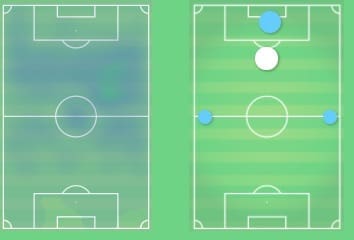
However, with further analysis of his heatmap we can also conclude that he prefers the right side of the pitch, where we’ll usually find him in the half-space or the no.10 zone. But whenever Lee is playing, Valencia’s tactics allow him to assume a freer role so he can move around the pitch without too many restrictions.
As such, he’ll drop deeper when necessary and swap wings if that benefits the team at that moment. Valencia can surely use his press-resistance and creativity in both progression and chance creation, which we’ll discuss further down the line of this tactical analysis.
Before going into in-game examples, let’s take a look at his player profile dashboard down below.
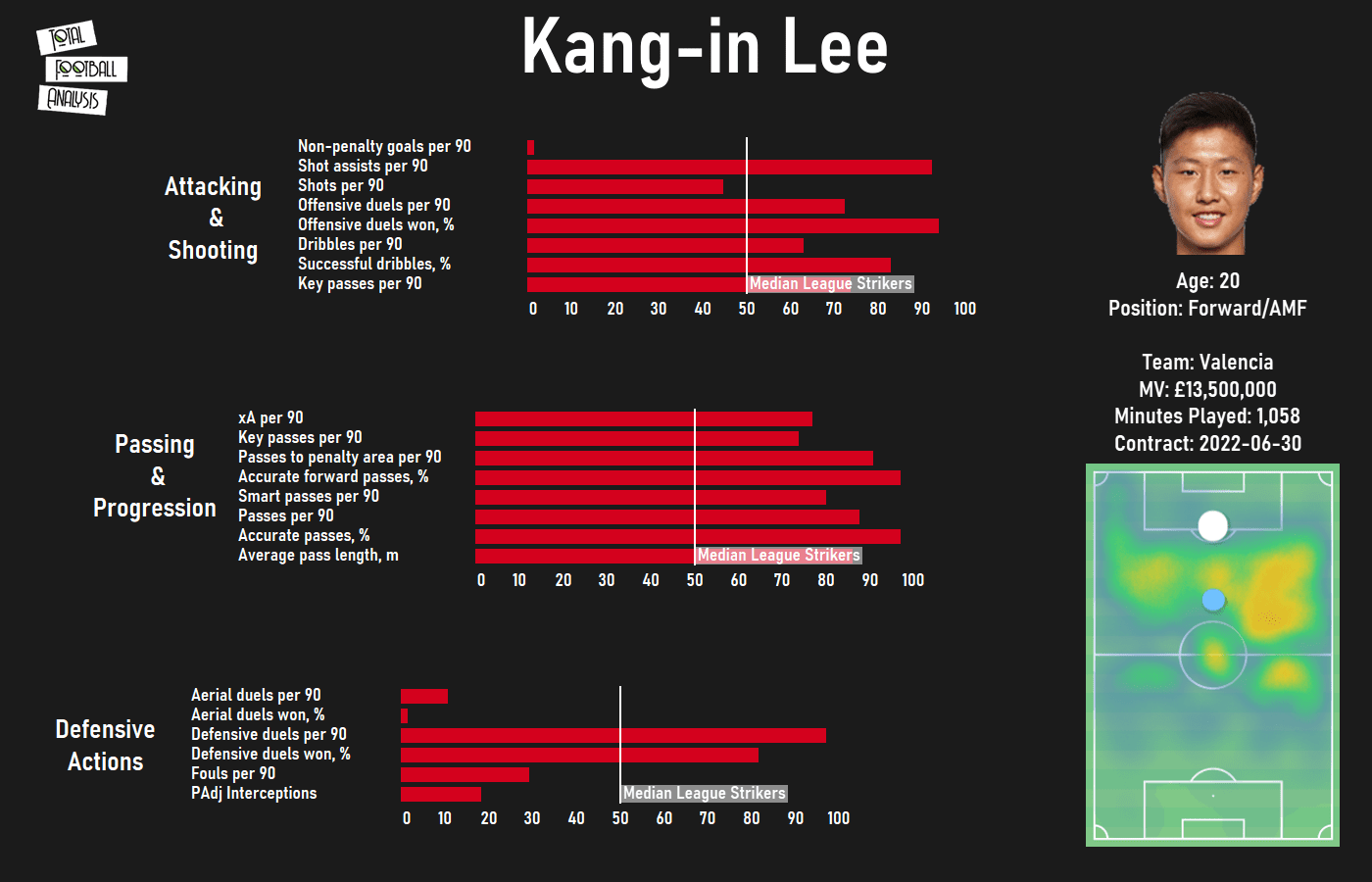
Looking at the numbers, we can immediately see what Lee excels at and what can still be further improved. His creativity comes from superb dribbling abilities, which can be seen both from the volume and success percentage, and excellent key passing and shot assists per 90 minutes.
It’s also interesting to see that he does extremely well in terms of progressions and passing as well. Compared to other attacking midfielders and forwards in La Liga, Lee is in the top 10%–20% in all of the main metrics. Looking at the average pass length, though, we can see that his progression is often done via long balls and quick side swaps, which is also part of Valencia’s overall tactics.
Even though he doesn’t register a lot of interceptions nor is he good in the air, Lee is aggressive in his pressing/ counter-pressing, tallying a high number of defensive duels too.
Creativity and chance creation
We’ve already mentioned in this tactical analysis that one of Lee’s greatest weapons are his dribbles. According to our data, he attempts more dribbles than around 60% of other La Liga attacking midfielders and strikers and is more successful than more than 80% of them too. In the domestic league so far in 2020/21, Lee attempted 3.32 dribbles per 90, completing 60.5% of them in the process.
Seeing how he prefers the right side of the pitch, it’s not surprising to see that’s exactly where most of his dribbles originate from. Below is a graphical representation of his dribbles in the last four games and it can tell us more about his tendencies.
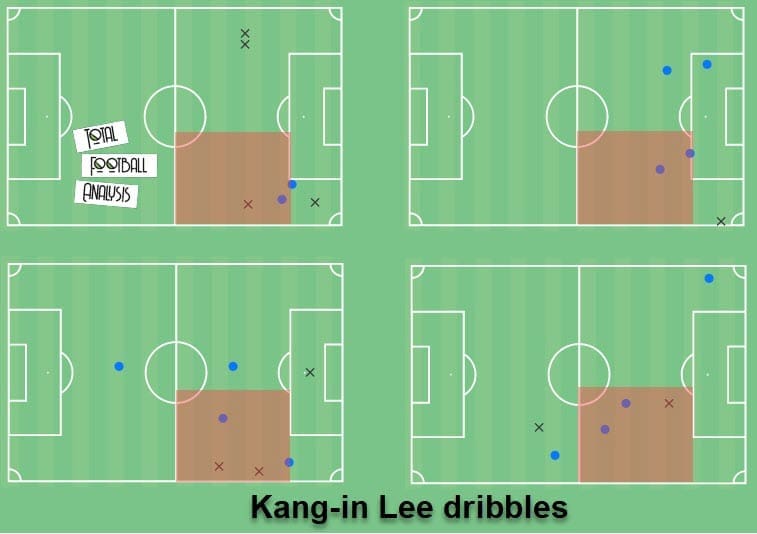
The graph once again confirms Lee often has the freedom to move across the pitch, seeing how he dribbles on both sides of the pitch and also in deeper areas where he uses it to help the build-up. However, it’s the right half-space, particularly from the halfway line to the box, that seems to be his favourite area of operation.
This scout report will now move onto some of the in-game examples of how Lee uses his dribbling to create chances and advantages for Valencia. The next image shows him receiving a pass in the right half-space and he’s immediately collapsed upon by two Levante players.
There seem to be two main ways the young Korean beats his man when dribbling. He either waits for the defender to attempt a tackle before shimmying to the side or uses quick bursts of pace to move past them.
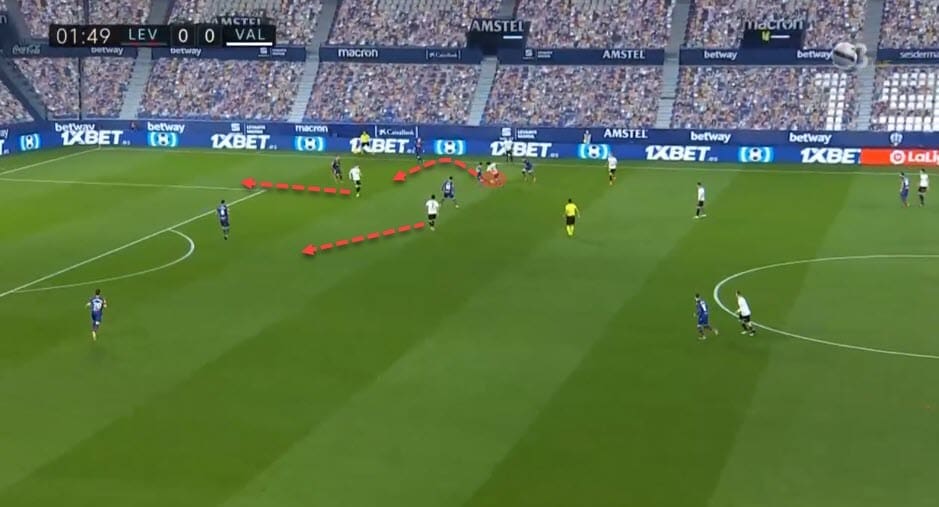
Above, we see the example of the latter as Lee progresses through the half-space towards zone 14 but unfortunately for Valencia, his final pass couldn’t connect with the target. However, it’s exactly this ability and control in tight spaces that boost their attack significantly. Our next example shows Lee in that same game against Levante and in a very familiar situation once again.
He receives possession in the right half-space and again uses his superb close control to avoid a tackle from two defenders, squeezing past them to get into a great situation to cross the ball. Interestingly, crossing does seem to be a formidable weapon in his arsenal with 31.1% accuracy. When we take into account that he deploys a high volume of key passes per game and prefers long balls as well, it’s easy to see why a good amount originate from his crossing.
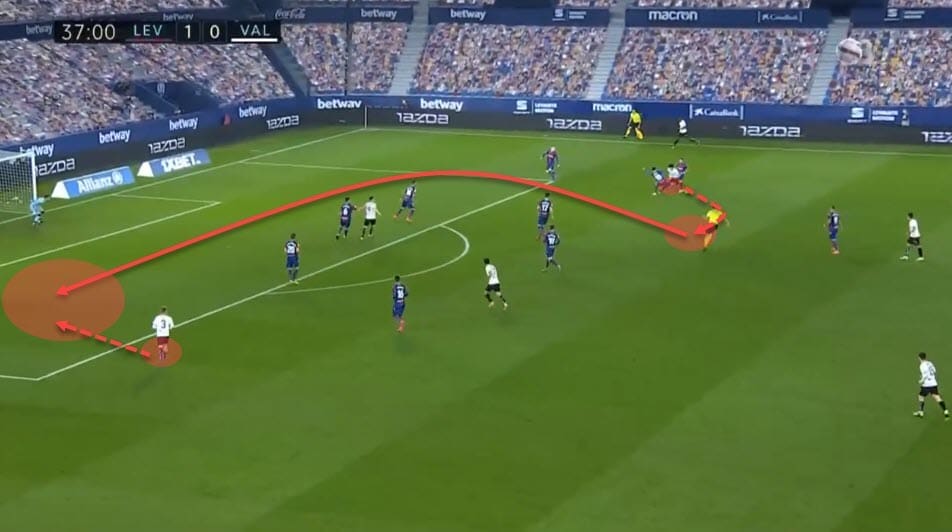
Lee is heavily left-footed so that’s why most of these chances start wider and then end up in the central channels as a result of his tendency to cut in from the flank. This way, he can position himself to release the pass with his left foot, ensuring more accuracy or even getting himself into a good position to shoot as well.
The final example of his dribbling we’ll cover in this section of the tactical analysis shows us how Valencia can use Lee’s gravity and close control to create space for his teammates elsewhere. Below, in the game against Villarreal, Lee is once again receiving possession in that usual right half-space area.
Upon getting the ball, the Korean skips between two defenders, once again using the quick turn of pace to beat his man.
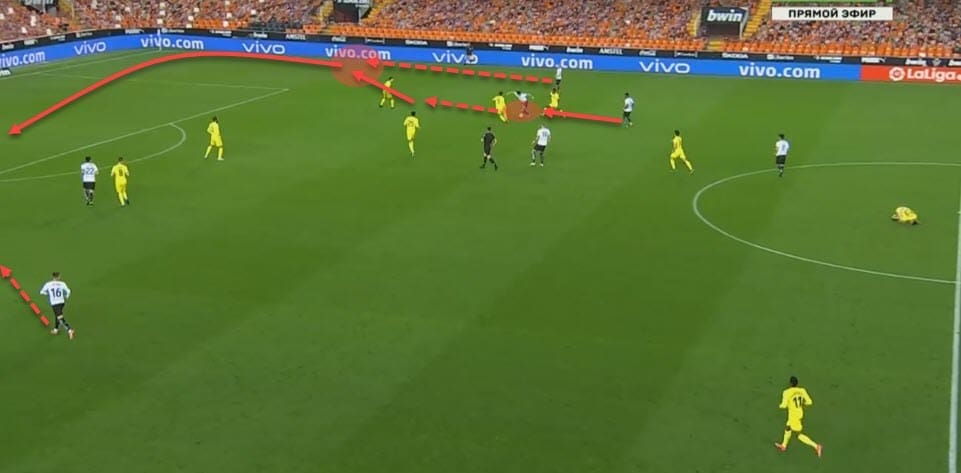
After that, with three defenders focusing solely on him, he can release his teammate into space on the right flank. That is followed by a cross that ends up in the box but Valencia can sadly not convert the chance.
And this is the other part that should be taken into account in this tactical analysis. Lee is registering extremely high figures in most attacking and progressions statistics despite playing for a largely struggling Valencia side. While that may make it easier to stand out within the squad, it makes it far more difficult to compete against other players in his position who play in far more structured and stable teams.
Press-resistance and progression
Another key attribute of Lee’s we have to mention is his ability to help progress the ball. Once again, this is something closely related to his technical abilities and dribbling, in particular. According to our data, with 3.83 passes to the final third (84.4% accuracy) and 3.06 passes to the penalty area (50% accuracy), he is firmly among the very best in Spain. Not only that, he edges out around 90% of other La Liga attacking midfielders and forwards in the latter category too.
So how exactly do his dribbling and close control help in those situations? As we’ve noted earlier in this scout report, Lee sometimes drops deeper to receive possession and in those cases, Valencia use his technicality to beat the press. We can see an example of that down below.
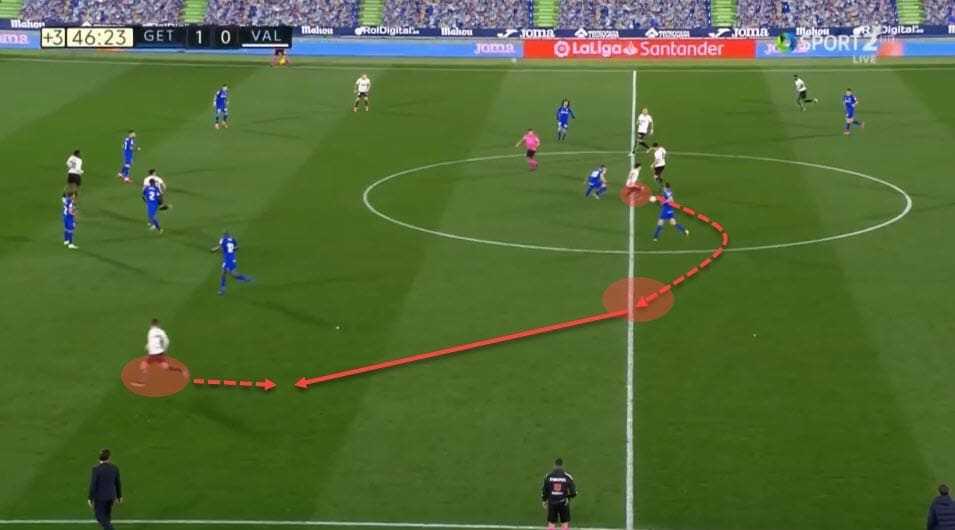
Here, Lee receives the ball against Getafe around the halfway line and is immediately pressed by the opposition. However, he uses his low centre of gravity to escape the press and advance towards the less crowded left side of the pitch.
This seems like a simple sequence but in reality requires calmness in possession and of course the control to execute it without losing the ball. In this scenario, most players would go for the immediate backpass to the backline but Lee can escape the press and advance the play in just a couple of touches.
Similarly, this can be used in attacking transitions too. Lee has enough pace to quickly cover the pitch and also the technical ability to create space for both himself and his teammates. In the following example he receives the ball with back to goal directly from the backline and we have to highlight two different things in such a scenario.
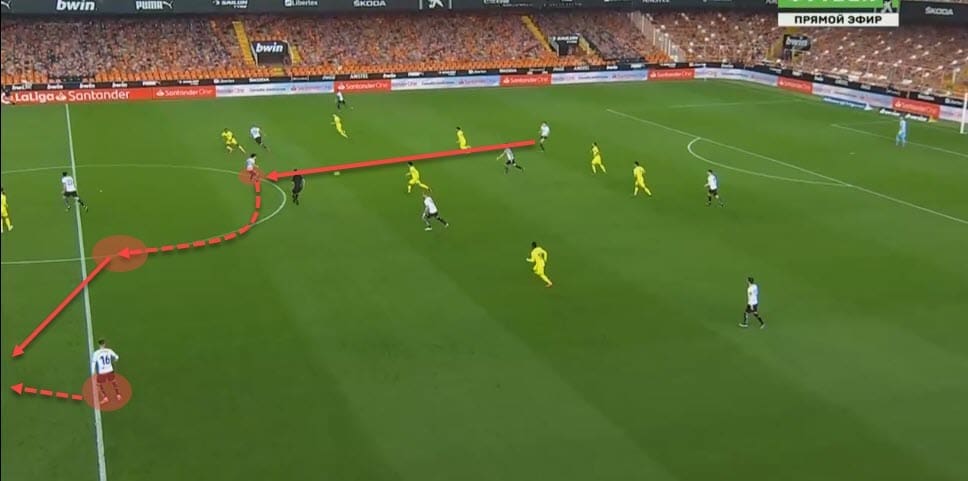
In a situation where he has a defender on his back, Lee can shield the ball and then either beat his man or lay off a pass to one of his teammates who are in space. Given his diminutive frame, this is a very impressive thing to do. But in our specific example above, the Korean is the one who receives without a marker on his back.
What’s particularly praise-worthy here though is how he receives the ball and then uses a single touch to turn and immediately advance up the pitch. Once he is challenged by a defender, he can use his dribbling to once again free himself and deploy a pass to the flanks. This doesn’t always end up successful, of course, as was the case in the example but is still an effective strategy for the Bats.
Our final example in this section of the scout report will highlight a very similar example of another progressive run, only this time much higher up the pitch. Again, we see Lee receive possession in his preferred position and now, after creating separation from his marker, he’s free to run with the ball.
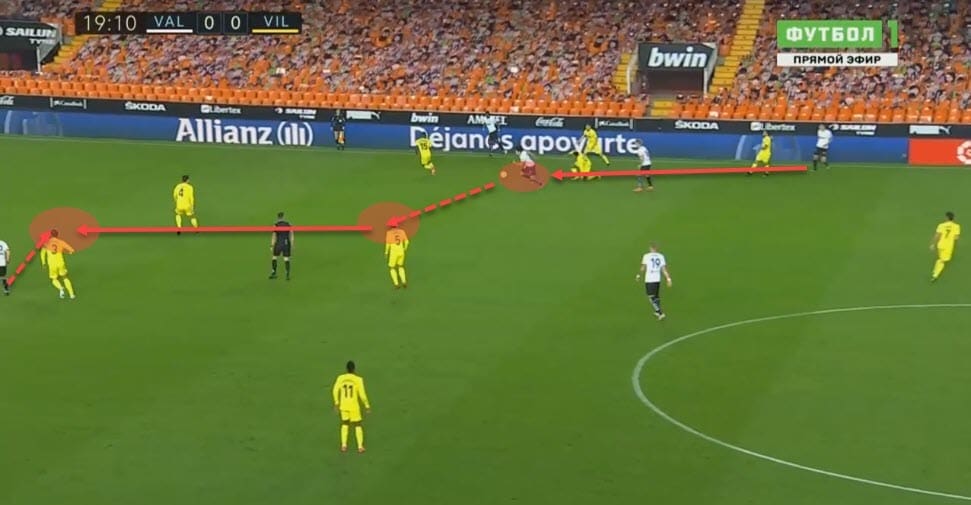
Similarly to before, he only needs one touch to turn and advance, getting into a good position to thread the ball towards his teammate. It’s situations like these that create great chances for Valencia, utilising both his dribbling, close control, awareness and great passing abilities.
But with all of that said, Lee is still not without flaws.
Weaknesses
If there is one thing Lee has to improve upon then it’s his final product. In front of goal, the young forward is simply too inefficient and zero goals from a total of 0.94 xG (0.08 on average) confirm as much. To get to the bottom of this issue, we’ve decided to analyse all of his shots in the 2020/21 La Liga season so far.
Below is the graph that can tell us more about his shooting tendencies. It’s important to note that the bigger the dot, the higher the xG of that particular shot.
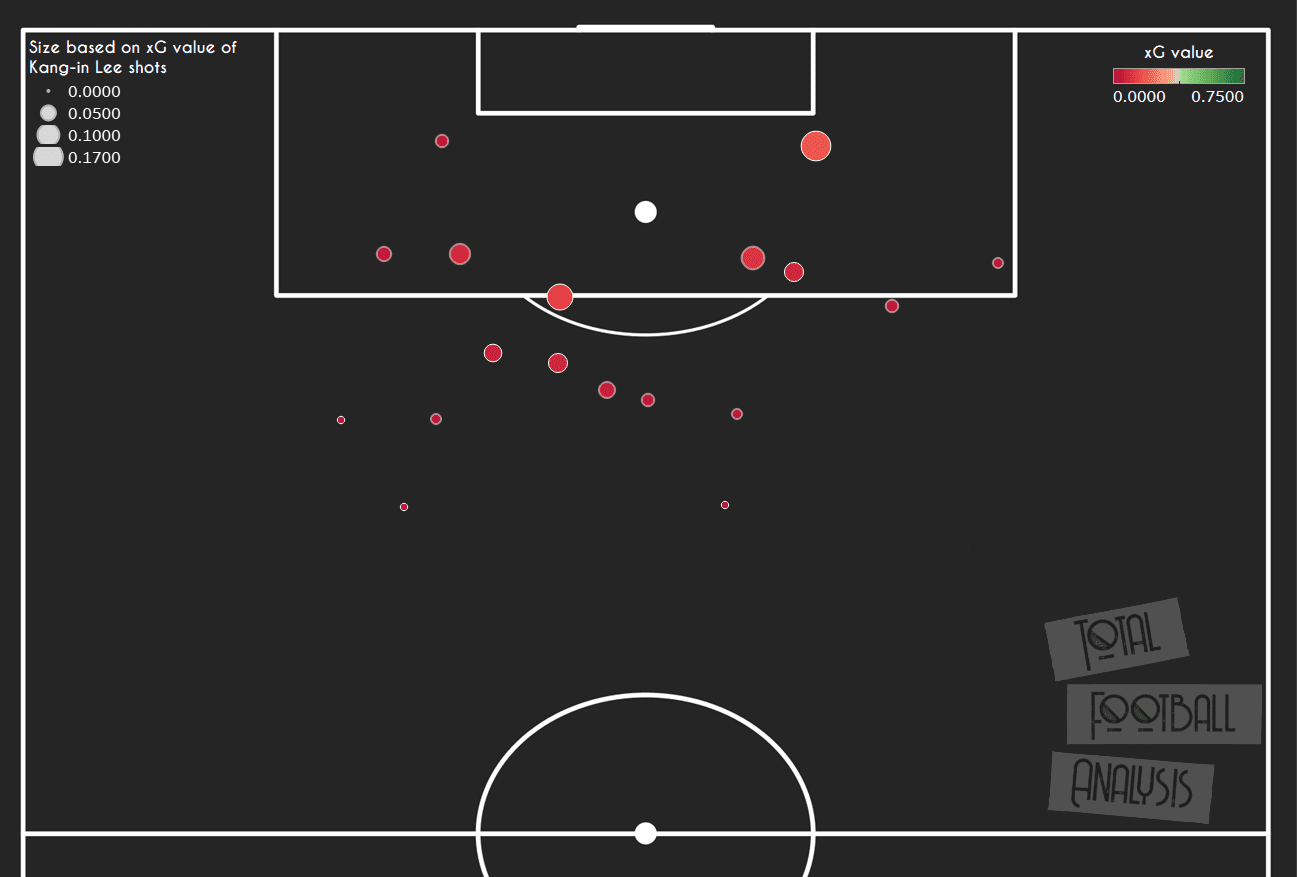
This season, Lee has taken 19 shots (1.62 on average) with only 10.5% hitting the target. Both of these figures are nowhere near good enough for him to contest other La Liga forwards and attacking midfielders, placing him around the bottom of percentile rankings in all three xG per 90, xG per shot and conversion percentage. As far as his shots volume goes, he ranks around the 45th percentile for shots per 90.
Upon further analysis, we can see that the reason behind these poor figures is his shot location. Lee simply shoots from bad positions on the pitch, often opting to let loose outside of the box and in congested areas. Let’s take a look at a couple of in-game examples of this.
The first one is against Villarreal where we see him a) shoot outside of the box and b) while being surrounded by four defenders, which results in a blocked attempt.
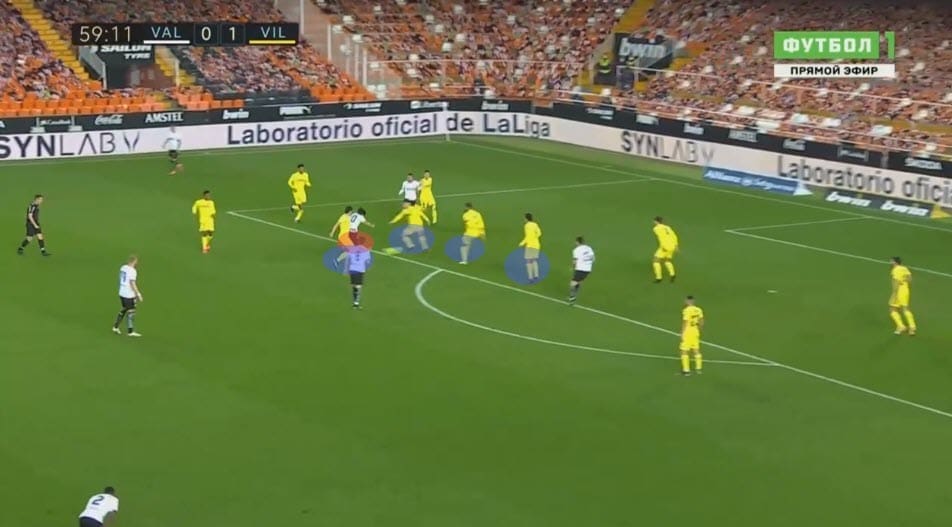
We can see practically the same thing against Cádiz in the next image as well. Here, the Valencia starlet is granted more space but it ends up in a rather similar way and an overall poor attempt by the 20-year-old.
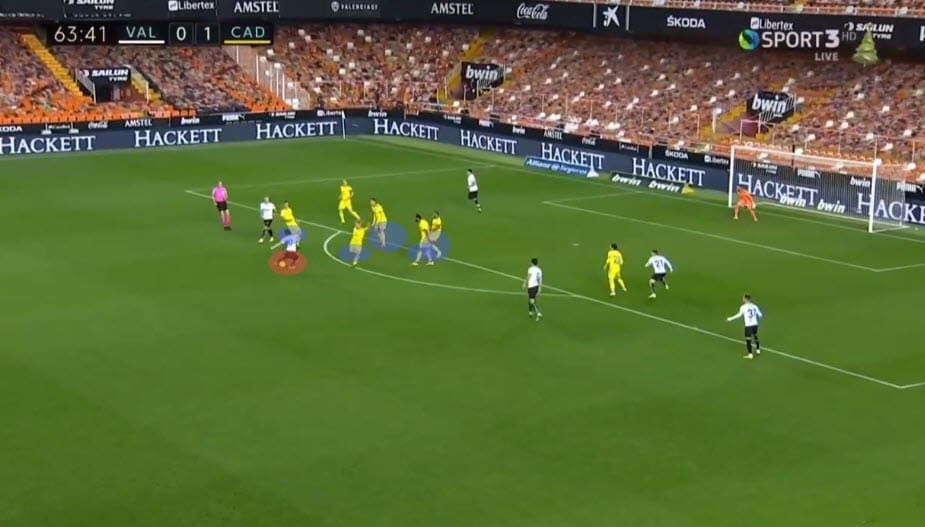
With only 1.02 touches in the box on average, we can see that this is indeed a problem for Lee as his box presence is lacking. Of course, he is often the creator and the one deploying passes into the danger area but despite making great runs, we rarely see him shoot from close range or good positions inside the box.
Conclusion
Every young player has at least one aspect he has to work on. Lee is no different. Despite his brilliance on the ball and an abundance of creativity, press-resistance and passing range, his presence in front of goal is the thing stopping him from being the full package.
Still, Valencia can be happy to have such an enormous talent in their ranks. Let’s see what the future has in store for him next and whether he could truly be their saviour.






Comments